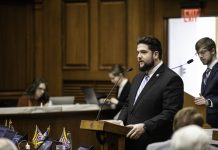Indiana Needs More Resources To Treat Opioid Addiction, Panel Told
By James Polston
TheStatehouseFile.com
INDIANAPOLIS — Indiana has come a long way in the battle with opioids but the state needs to continue to do more, Sen. Jim Merritt, R-Indianapolis, said during a committee meeting Thursday.
“As a state, we need to do anything and everything we can to help those who are addicted get the help they need to recover and live a better, healthier life,†Merritt said in a statement released after the Interim Study Committee on Public Health, Behavioral Health, and Human Services meeting Thursday.
The committee met to discuss resources available for addiction treatment and the impact that opioid treatment programs have had on the areas they serve.
“It’s not over, it’s not going to be over soon,†Merritt said during the meeting. “But we have come strides and we have the tools out there.â€
Merritt said the state needs more treatment facilities, doctors, nurses, psychiatrists, psychologists, and social workers.
“We need to continue to work on destroying this opponent, this stigma, this epidemic, really, this monster,†Merritt said.
During Merritt’s presentation, he noted that the state has opened five new Opioid Treatment Programs (OTPs) since June, raising the number of OTPs to 18 in 15 cities.
Merritt also said there are eight syringe service programs in Indiana, with the ninth opening soon in Marion County. He also said the state has 164 community mental health centers and 60 licensed recovery residences.
Kevin Moore, director of the Division of mental health and addiction said the goal for the state is to have a treatment facility or resource within an hour drive of anywhere in the state.
“Opioid misuse negatively affects not only individuals but also our economy,†Merritt said.
A 2018 study by the Indiana Business Review shows that Indiana has sustained $43.3 billion in economic damages to date as a result of opioid misuse.
“This number includes direct costs, which are losses associated with products and services to combat the epidemic, and indirect costs, which are losses to gross state product due to lost work productivity,†Merritt said. “Having ongoing discussions on this crisis is critical as we form a plan of attack for the upcoming legislative session.â€
FOOTNOTE: James Polston is a reporter for TheStatehouseFile.com, a news website powered by Franklin College journalism students.






It’s not going to get better as long as Indiana keeps hiring private organizations to treat addiction. These harm reduction centers treat pts. as profit centers not as persons needing treatment.
Comments are closed.